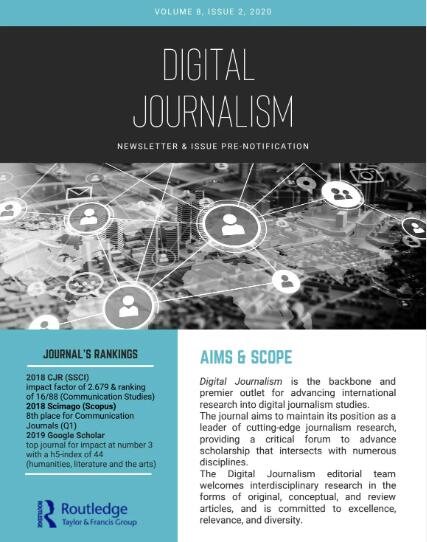Conceptualizing Journalists’ Safety around the Globe
IF 5.2
1区 文学
Q1 COMMUNICATION
引用次数: 2
Abstract
Abstract Killings, as the most extreme form of violence against journalists, receive considerable attention, but journalists experience a variety of threats from surveillance to gendered cyber targeting and hate speech, or even the intentional deprivation of their financial basis. This article provides a comprehensive, interdisciplinary framework of journalists’ safety, summarized in a conceptual model. The aim is to advance the study of journalists’ safety and improve safety practices, journalism education, advocacy, and policy making - vital as press freedom and fundamental human rights face multifaceted challenges, compromising journalists’ ability to serve their societies. Journalists’ occupational safety comprises personal (physical, psychological) and infrastructural (digital, financial) dimensions. Safety can be objective and subjective by operating on material and perceptional levels. It is moderated by individual (micro), organizational/institutional (meso), and systemic (macro) risk factors, rooted in power dynamics defining boundaries for journalists’ work, which, if crossed, result in threats and create work-related stress. Stress requires coping, ideally resulting in resilience and resistance, and manifested in journalists’ continued role performance with autonomy. Compromised safety has personal and social consequences as threats might affect role performance and even lead to an exit from the profession, thus also affecting journalism’s wider function as a key institution.全球记者安全概念化
摘要杀害作为针对记者的最极端暴力形式,受到了相当大的关注,但记者面临着各种威胁,从监视到性别化的网络攻击和仇恨言论,甚至是故意剥夺他们的经济基础。本文提供了一个全面的、跨学科的记者安全框架,并在概念模型中进行了总结。其目的是推进对记者安全的研究,改善安全实践、新闻教育、宣传和政策制定,这对于新闻自由和基本人权面临多方面挑战,损害记者为社会服务的能力至关重要。记者的职业安全包括个人(身体、心理)和基础设施(数字、金融)两个方面。安全可以是客观的,也可以是主观的,通过在物质和感知层面上操作。它受到个人(微观)、组织/机构(微观)和系统(宏观)风险因素的调节,这些因素植根于界定记者工作界限的权力动态,如果越过这些界限,就会导致威胁并产生与工作相关的压力。压力需要应对,理想情况下会产生韧性和抵抗力,并表现在记者持续的自主角色表现中。安全受到损害会产生个人和社会后果,因为威胁可能会影响角色表现,甚至导致退出该行业,从而也会影响新闻业作为一个关键机构的更广泛职能。
本文章由计算机程序翻译,如有差异,请以英文原文为准。
求助全文
约1分钟内获得全文
求助全文
来源期刊

Digital Journalism
COMMUNICATION-
CiteScore
11.20
自引率
24.10%
发文量
103
期刊介绍:
Digital Journalism provides a critical forum for scholarly discussion, analysis and responses to the wide ranging implications of digital technologies, along with economic, political and cultural developments, for the practice and study of journalism. Radical shifts in journalism are changing every aspect of the production, content and reception of news; and at a dramatic pace which has transformed ‘new media’ into ‘legacy media’ in barely a decade. These crucial changes challenge traditional assumptions in journalism practice, scholarship and education, make definitional boundaries fluid and require reassessment of even the most fundamental questions such as "What is journalism?" and "Who is a journalist?" Digital Journalism pursues a significant and exciting editorial agenda including: Digital media and the future of journalism; Social media as sources and drivers of news; The changing ‘places’ and ‘spaces’ of news production and consumption in the context of digital media; News on the move and mobile telephony; The personalisation of news; Business models for funding digital journalism in the digital economy; Developments in data journalism and data visualisation; New research methods to analyse and explore digital journalism; Hyperlocalism and new understandings of community journalism; Changing relationships between journalists, sources and audiences; Citizen and participatory journalism; Machine written news and the automation of journalism; The history and evolution of online journalism; Changing journalism ethics in a digital setting; New challenges and directions for journalism education and training; Digital journalism, protest and democracy; Journalists’ changing role perceptions; Wikileaks and novel forms of investigative journalism.
 求助内容:
求助内容: 应助结果提醒方式:
应助结果提醒方式:


